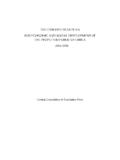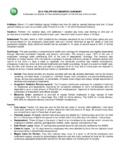Transcription of Flexible Spending Accounts 1 - ResourceONE
1 Flexible Spending Accounts 1 10/10 2B1B0B1 HHOW THE Flexible Spending Accounts WORK Follow these steps to put the Flexible Spending Accounts to work for you: Estimate Your Expenses Each fall, you calculate these expenses for the upcoming year : any out-of-pocket medical, dental, and vision care expenses, prescription and over-the-counter drug expenses and your dependent care expenses. You should estimate carefully because you will forfeit any unused funds. Decide On Your Contribution You can contribute from $100 to $5,000 before-tax to the health care Spending account and from $100 to $5,000 before-tax to the dependent care Spending account . The two Accounts are separate, and you may not transfer funds between the two. Once you begin contributing, you may not change or stop your contributions during the year unless you have a qualifying event.
2 PLAN HIGHLIGHTS ..Give You Choices If you are an eligible Full-time Employee, you can contribute to the health care Spending account , the dependent care Spending account or both. Each year , you can contribute up to $5,000 to the health care Spending account to pay for un-reimbursed medical, dental and vision expenses, as well as prescription and over-the-counter* drug expenses and up to $5,000 to the dependent care Spending account to pay for day care and elder care expenses for eligible dependents. *Beginning January 1, 2011, over-the-counter drugs are not an eligible medical expense unless prescribed by a doctor..Offer Convenience Your Flexible Spending account contributions are automatically deducted from each paycheck and credited to your Flexible Spending Accounts ..Save You Money in Taxes The money in your Accounts is not subject to Federal income taxes, Social Security taxes or Medicare taxes.
3 And, in most places, state and local taxes also do not apply. This means that many of your routine health and dependent care services will actually cost you less..Require Careful Planning Enrollment does not automatically extend from one year to the next. You need to estimate your expenses for the upcoming year carefully when deciding how much to contribute to the Flexible Spending Accounts . The health care Spending account offers a grace period to minimize the risk of forfeiting funds. According to Internal Revenue Service rules, any money left in your health care Spending account at the end of the grace period for the plan year or in your dependent care Spending account at the end of the plan year will be forfeited. Flexible Spending Accounts 2 10/10 Should you participate? Here are some questions you may want to ask yourself before you decide to contribute to a Flexible Spending account : What Do You Expect Your Out-Of-Pocket Health Care Expenses To Be?
4 Start with your deductibles, and then add any medical, dental, vision, prescription or over-the-counter drug expenses that are not covered such as co-payments, charges above reasonable and customary or charges above plan maximums. What Do You Expect Your Dependent Care Expenses To Be? Consider any times of the year when you do not have these expenses, such as vacation periods. Also, if your child will turn 13 during the year , estimate your expenses only for the portion of the year before your child s 13th birthday. File A Claim When you have eligible expenses, you pay for them as you normally would. Then you submit a receipt, reimbursement request and any other supporting documentation to the claims administrator. Refer to the Contact Information section for the Member Services number and web site address to access account information and instructions on how you can file a reimbursement claim.
5 Receive Reimbursement Reimbursements from your Accounts are made with before-tax dollars. Changing Your Contribution You may not change or stop your contributions to the Flexible Spending Accounts during the year unless you have a qualifying event, such as a birth, marriage or a job loss by your spouse. If you stop contributing to the Flexible Spending Accounts , you can be reimbursed only for eligible health and dependent care expenses incurred before you stopped contributing. Tax Savings The health care and dependent care Spending Accounts are designed for one purpose: to help you save on taxes. Your taxable income is reduced by the amount you contribute to the Accounts . How much can you save on taxes? Suppose you contribute $1,000 to the health care Spending account and are in the 15% Federal tax bracket. You could save $150 in Federal income taxes and $ in Social Security and Medicare taxes for a total of $ Your savings are even greater when you add state and local tax savings.
6 Your participation in the Accounts may reduce your Social Security retirement benefits. The current tax advantages generally offset any reduction in Social Security benefits. Flexible Spending Accounts 3 10/10 Tax Savings: An Example Amount you Contribute Estimated Annual Federal Income Tax Savings 15% Tax Bracket 25% Tax Bracket 28% Tax Bracket $100 $15 $25 $28 $250 $38 $63 $70 $500 $75 $125 $140 $1,000 $150 $250 $280 $3.
7 000 $450 $750 $840 $5,000 $750 $1,250 $1,400 Note: This example only takes Federal income tax savings into account . You may also save an additional on Social Security taxes, on Medicare taxes and, depending on where you live, state and local taxes. HEALTH CARE Spending account Contributions Eligible Full-time Employees may contribute from $100 to $5,000 annually to the health care Spending account . Contributions are deducted from your pay each pay period and credited to your Flexible Spending account . Limit for Highly Compensated Employees Certain highly compensated employees may be limited by the Internal Revenue Service as to how much they can contribute to the health care Spending account annually.
8 You will be notified if this limit applies to you. Eligible Expenses and Dependents You can use the health care Spending account to pay for un-reimbursed medical, dental and vision care expenses, as well as prescription and over-the-counter drugs prescribed by a doctor, for you and your eligible dependents. Eligible dependents are your spouse and anyone you claim as a dependent on your Federal income tax return. Eligible dependents do not have to be covered under the Company s medical or dental plans. If you are divorced or legally separated, your child may be an eligible dependent even if not claimed as a dependent on your return. In general, you may be reimbursed for any health care expense that is not paid for by an insurance plan and is considered a deductible medical expense by the Internal Revenue Service. However, you cannot Flexible Spending Accounts 4 10/10 claim, as an income tax deduction, any expenses reimbursed or payable through the health care Spending account .
9 Generally, eligible health care expenses currently allowable by the Internal Revenue Service include, medically necessary: Fees for physicians, surgeons, dentists, ophthalmologists, optometrists, chiropractors, podiatrists, psychiatrists, psychologists, social workers and Christian Scientist practitioners Fees for hospital services, therapy, nursing services, ambulance fees, laboratory, surgical, obstetrical, diagnostic, dental and x-ray services Rehabilitation services Special equipment, such as wheelchairs, special handicapped automotive controls and special phone equipment for the deaf Special items, such as dentures, artificial limbs, contact lenses, eyeglasses, hearing aids, crutches and guide dogs for the vision or hearing impaired Prescription medicines, drugs and insulin (drugs that require a Rx) Cost of vasectomies, hysterectomies and birth control Acupuncture Radial keratotomy Non-elective cosmetic surgery Non-prescription drugs (over-the-counter) Beginning January 1, 2011, non-prescription over-the- counter drugs are allowed as a deductible medical expense only if prescribed by a doctor.
10 Ineligible Expenses Generally, health care expenses that are ineligible for reimbursement through the account include: Expenses incurred before your date of participation Expenses reimbursed through any other policy, plan or program Expenses claimed as a deduction or credit on your Federal income tax return Elective cosmetic surgery Orthodontia for cosmetic purposes Tooth-whitening procedures Marriage or family counseling fees Flexible Spending Accounts 5 10/10 Household and domestic help, even if recommended by a doctor Custodial care in an institution Funeral and burial expenses Illegal operations or treatments Weight-loss classes or programs, unless prescribed by a doctor to treat an existing disease Maternity clothes, diaper services, etc. Vitamins or food supplements taken for general health purposes Cosmetics, toiletries, etc.






